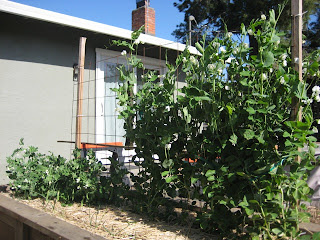 |
| Pea vines in early November |
By March the vines were lush, and soon we were harvesting bushels of tasty snap and shelling peas.
 |
| Shelling peas on the left, snap on the right |
After giving an abundance of peas all season, the vines are now done.
 |
| Vines are dry and ready to be picked over for seed peas. |
Normally when I consider saving seeds, I have to pay attention to whether the seeds I used in the first place were hybrid or heirloom/open-pollinated. Hybrid seeds are bred from different parent plants and consequently the second generation won't breed "true" (won't reproduce consistently.) If you save hybrid seed, you may be surprised by the fruit that ends up on next season's plant. Open-pollinated (heirloom) seeds, however, breed true to type and can be saved. If you want more info about this, OSU Extension explains the differences between hybrid and heirloom seeds on its site.
Happily, most of the peas on the market for the home gardener are open-pollinated and can be saved. The first step is to let the peas dry out on the vine while it's still in the ground.
 |
| Heirloom shelling pea to be used for seed next year. |
After that's done, I remove the last of the nearly-dry peas and finish drying them either on screens or in trays, out of the rain if that is forecast, or out of the direct afternoon sun if it's really hot out.
 |
| Seed peas drying out in a black tray. |
Next, I remove the peas from the brittle pods. If the peas feel at all moist, they sit on a plate for a few extra days. Then I pour them into an empty packet I saved in the fall; no need to find new containers for the saved seed.
 |
| Dried peas are ready for storage until fall. |
Finally, I slap on a quick "Saved" label with the date, and file the seeds away in a cool location. I keep seed packets in an old computer floppy disk storage container in the bottom of the wine fridge, which is about 15-20 degrees cooler than the house.
 |
| Saved seed ready for storage. |
So, why go to all that trouble if a packet of seeds is only a few dollars? Well, for one thing, it's easy and relatively quick. Also, when you love peas and want enough plants to eat fresh and also process and freeze peas for the rest of the year, you'll need to plant several packets. It adds up, and I'd rather spend my hard-earned pennies on a packet of fancy hybrid squash seeds or a new variety of melon or cucumber.
Have you every tried saving seeds? Think you might give it a shot?
No comments:
Post a Comment